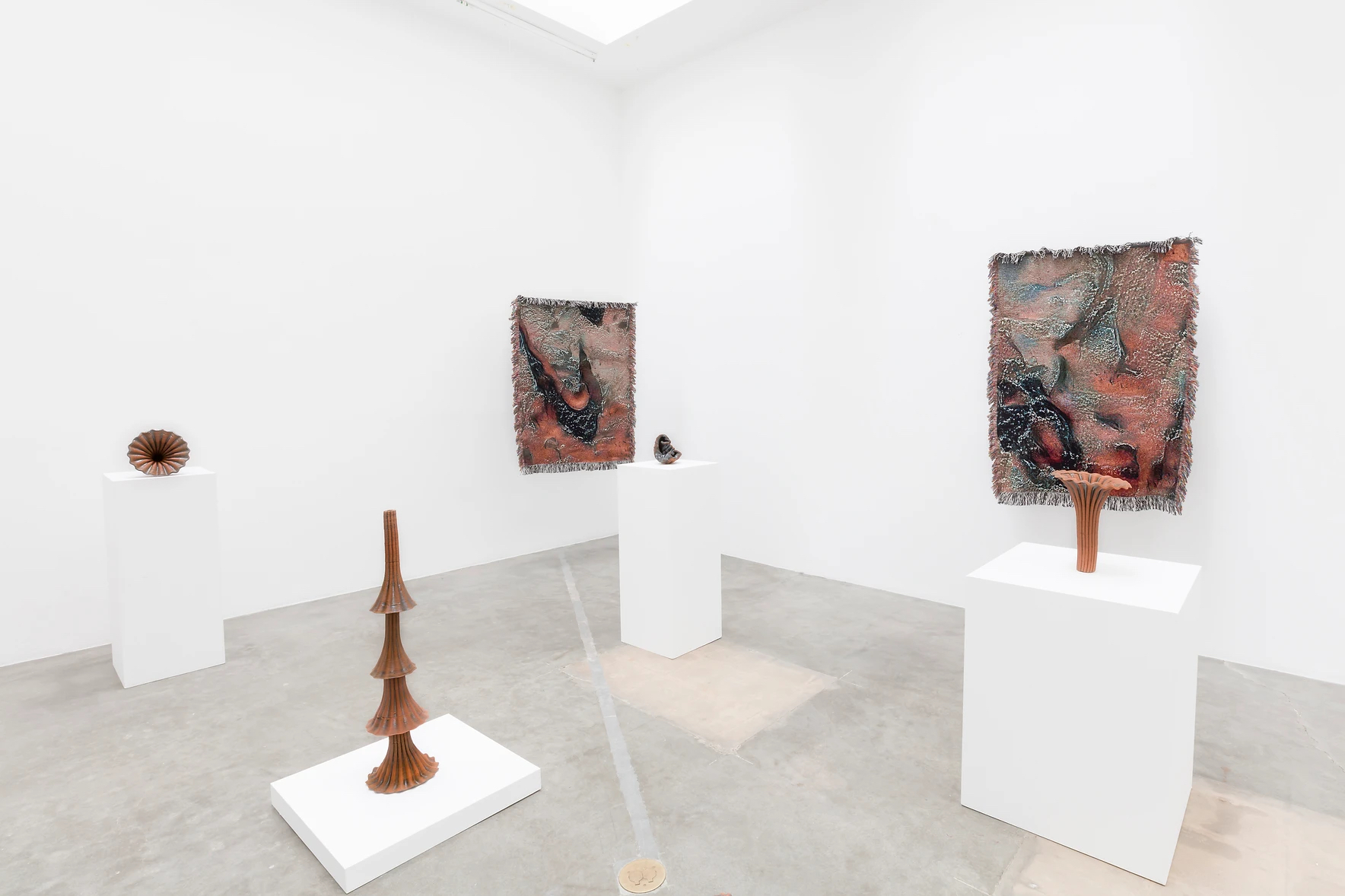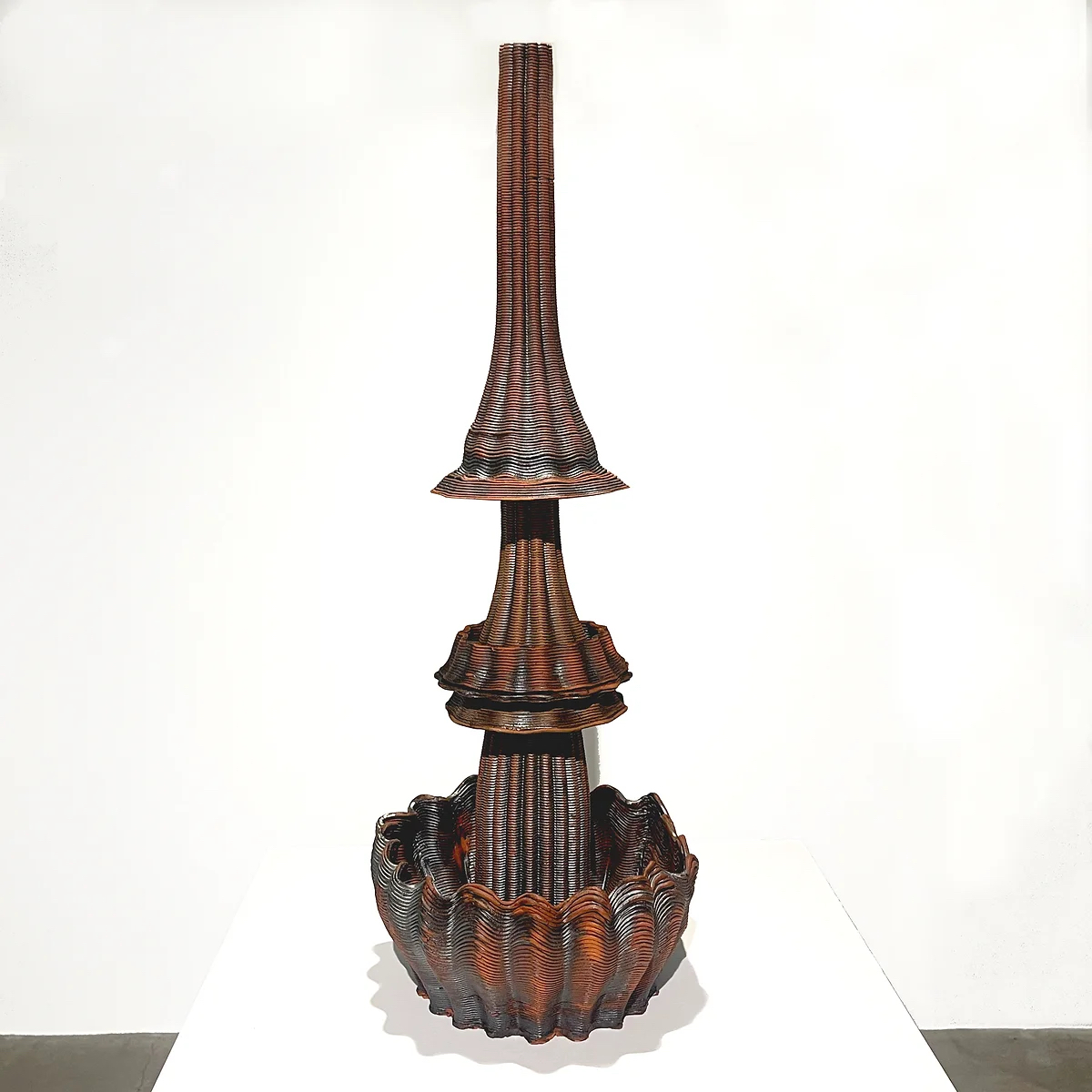An Artist Combines Indigenous Textiles With Modern Tech
6:51 minutes

When multidisciplinary artist Sarah Rosalena looks at a loom, she thinks of computer programming. "It's an extension of your body, an algorithm," he says.
Rosalena, a Wixarika descendant and assistant professor of art at the University of California, Santa Barbara, combines traditional indigenous crafts (weaving, beadwork, ceramics) with new technologies such as artificial intelligence, data visualization and 3D printing. And work with scientists to bring these otherworldly creations to life. He commissioned researchers at NASA's Jet Propulsion Laboratory to create 3D-printed ceramics from simulated Martian clay. And he collaborated with the Mount Wilson Observatory to create intricate beaded tapestries based on glass plates captured by the observatory's telescopes in the early 20th century, which mathematicians used for astronomical calculations.

And this is also an important goal for Rosalena: to highlight the overlooked contributions of women in IT and combine this with the fact that textiles are traditionally considered a woman-centric profession. When she began creating this type of art, Rosalena learned that the Jacquard loom, an 18th-century textile advance based on a binary punch card system that allowed for mass production of complex designs, inspired computer pioneer Ada Lovelace when it was first times created. he. . "[They] have this crazy story," he says. "And when I knit or bead, it also reminds me of that relationship."
But for Rosalena, her decision to combine new and old media is exciting and troubling. "We're at the technological frontier at this point and it's actually scary for a lot of people, especially people with my and Wixárika's backgrounds," he says. "That's progress for some, but not for all."
Part of Rosalena's work involves predicting future forms of colonization, especially given the rapid changes in our planet's climate and the rise of AI. “What happens if we combine traditional crafts or indigenous techniques with new technologies to think about the current problems we face? "Digital technologies are always looking for ways in which we can simulate our reality and thus give us the opportunity to reimagine our reality," he says.
SciFri producer and host of our Universe of Art podcast, D. Peterschmidt, sat down with Rosalena to talk about how she approaches her work, why she collaborates with scientists, and how she hopes her art engages people with today's technology involve. Looking at progress from an indigenous perspective. do
You can see Rosalena's work through February 4th in the exhibit "Sarah Rosalena: The Columbus Museum of Art" at the Columbus Museum of Art in Columbus, Ohio.
More information
Segment gas
Sarah Rosalena is an interdisciplinary artist and assistant professor of art at the University of California, Los Angeles, Santa Barbara.
IRA FLATOW: Woven textile patterns can tell a powerful story, and Sara Rosalena knows this very well. He is a multidisciplinary artist who combines ancient media and indigenous knowledge with data and new technologies. He has worked with NASA JPL and the Los Angeles County Museum of Art Technology Laboratory. And his work is currently on view at the Columbus Museum of Art, Columbus, Ohio, through February 4.
SciFri producer and host of our Universe of Art podcast, D Peterschmidt, sat down with Rosalena to talk about working with scientists, space colonization, and how she views technological advancement through an indigenous lens. From here on.
VAN PETERSCHMIDT: When Sarah Rosalena thinks of looms, she thinks of computer programming.
Sarah Rosalena: It's an extension of your body as an algorithm.
BY PETERSCHMIDT: Ada Lovelace, who wrote the first design algorithm for a computer, said she was inspired by the 19th-century Jacquard loom, which used a binary punch card to mass-produce complex textile patterns. And this approach to combining old media with new technology sums up Rosalena's approach to her own art. He is an assistant professor of art at UC Santa Barbara, based in Los Angeles. And he is of Wixárika descent, the indigenous people of what is now Mexico and part of the southwestern United States.
He works in these older art forms (textiles and ceramics), but uses artificial intelligence and data visualization as part of the creative process. It is a way to process your feelings about the progress of modern society.
Sarah Rosalena: We are at the technological frontier at this point. And it's absolutely terrifying to a lot of people, especially people around me and around Wixarica. We live in a time of climate change, dispossession and the rise of AI. And I'm always interested in guessing future forms of colonization, because for some it's progress, but for everyone it's not.
From Peterschmidt: Rosalena, a fourth-generation Wixarica weaver, learned local traditional textile work from her grandmother.
Sarah Rosalena: It made her feel very intelligent. I think she always encouraged me to knit for mental health, but it was also good to exercise the mind.
Dr. Peterschmidt: After college, Rosalena landed in the Bay Area during the last tech boom and learned to code.
Sarah Rosalena: And during that time I met a lot of interesting people who were a lot like me. Many BIPOC employees work in code. But at the same time, new tech companies started to take off, replacing many of the people I loved hanging out with.
Van Peterschmidt: Disillusioned, she returned to Los Angeles and rediscovered her love of textile work.
Sarah Rosalena: I saw so many connections between the code I wrote and the designs I weave that didn't overlap. It was almost like an aha moment. What really happens to traditional crafts or indigenous techniques with new technology? Think about the current problems we face. Digital technologies always follow how we can simulate our reality, which in turn creates how we can reimagine our reality.
VAN PETERSCHMIDT: And Rosalena does not limit herself to rediscovering reality with herself. He often collaborates with scientists to create his art.
Sarah Rosalena: As an artist, it is challenging to work with scientists and engineers because we see the world differently. And it has great value.
D PETERSCHMIDT: One of those collaborations was with NASA's JPL in Pasadena. And Rosalena discovers that they have a common interest: sound. The space agency has been experimenting with simulated Martian soil, also known as regolith, to create potentially habitable habitats for humans on the Red Planet without transporting heavy construction materials from Earth.
Sarah Rosalena: You did a lot of research on regolith and clay simulants to build some of the first clay colonies, which made me laugh. Because it again depends on the extent to which space colonization is based on indigenous knowledge of other planets.
D PETERSCHMIDT: Rosalena teaches spiral pottery at UC Santa Barbara, an indigenous pottery method that is among the oldest in the world. A reel seat looks like this. The clay rolls are laid on top of each other until the pot is obtained. And he wanted to update it with a Martian technological twist. With the help of NASA engineers, he was able to create his own version of the Martian soil, based on soil analysis done by JPL rovers such as Curiosity.
He modeled the ship on a computer and then printed it in 3D with his Martin Adobe. The resulting sculpture appears both futuristic and ancient. The grooved, rust-stained ceramic takes on various forms: the mouth of a black hole, a long cylinder that appears to be consuming itself, and a vaguely spherical shape that appears to have been crushed by gravity. And Rosalena's passion for ceramics even rubbed off on JPL engineers.
Sarah Rosalena: I actually made a lot of friends. Some of them were interested in ceramics at the time, which was really interesting because the Mars cartographers who were driving the rovers suddenly became interested in the chemical compounds of clay. And we talked for hours about finding local clay and making it in Los Angeles.
D PETERSCHMIDT: Just a few kilometers from JPL is the Mount Wilson Observatory, which Rosalena also works with. At the beginning of the 20th century it was an important observatory. Edwin Hubble used his telescope to show that the universe is expanding. But such discoveries would not have been possible without the help of women's computers. The women who analyzed the telescope's raw data and did the complex calculations that made these discoveries possible.
Sarah Rosalena: But when I got there, I realized that the women's computers had been largely removed and erased from the history of this observatory.
D PETERSCHMIDT: The telescope images were then displayed on glass plates, which were used by female computers to calculate them.
Sarah Rosalena: And I found textiles to be a unique focus because it's a feminist or women-oriented craft.
BY PETERSCHMIDT: To highlight the work of these women, Rosalena took the panels and scanned them at low resolution, transforming each pixel into a strand of a tapestry that she then pieced together by hand. But not all these tapestries are neat rectangles; Some of them contort and look like cosmic star jellyfish as the beads descend.
Rosalena hopes that her art will not only serve as a form of protest, but also provide an alternative way of interpreting the world around us, with a strong emphasis on indigenous knowledge.
Sarah Rosalena: This is very important because many of the current crises we face are humanitarian crises. And I feel that artists can really bring that light and see the world differently than a scientist or an engineer. And we can learn a lot from each other.
Dee Peterschmidt: For Science Friday, my name is Dee Peterschmidt.
IRA FLATOW: Thanks, D. You can see images of Rosalena's work at sciencefriday.com/textileart. And as I mentioned, his art is on view at the Columbus Museum of Art in Columbus, Ohio, through February 4th.
Copyright © 2023 Science Friday Initiative. All rights reserved. Science Friday transcripts are produced by 3Play Media on a tight deadline. Fidelity to the original transmitted/published audio or video may vary and the text may be updated or corrected in the future. For an authentic recording of the Science Friday program, see the original broadcast/released recording. For terms of use and more information, please see our policies pages at http://www.sciencefriday.com/about/policies/
Meet the producers and presenters
About Ira Flatow
@eraflatoIra Flatow is the host and executive producer of Science Friday . His green thumb gave new life to many office factories.



0 Comments:
Post a Comment
Subscribe to Post Comments [Atom]
<< Home